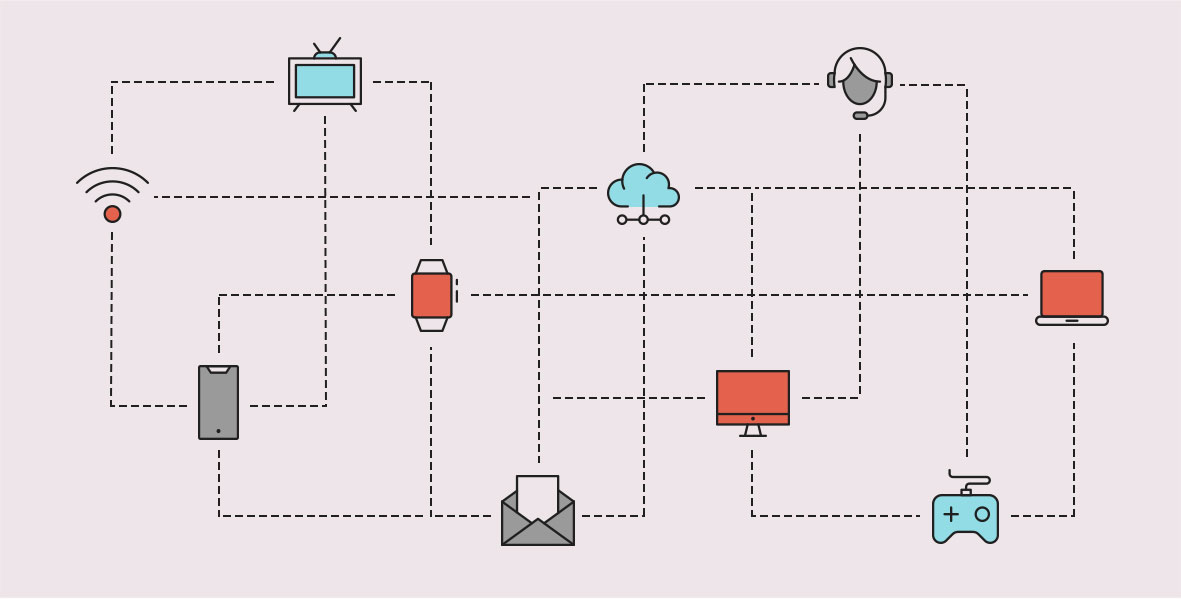
The customer journey is no longer a linear path along which businesses can engage with consumers at logical, predictable touchpoints. Today, it’s meandering and fractured. Consumers make decisions and engage with brands on mobile apps, social media platforms, websites and more—while they’re at home, at work, in transit and everywhere in between.
These interactions are called moments, and consumers expect businesses to add value to all of them. To create meaningful moments that matter, you need to remove the boundaries between channels. You need to deliver consistent but flexible messaging that adjusts to consumers based on their journey, making the customer experience as convenient as possible.
In short, you need to embrace an omnichannel, or moment-based, marketing strategy.
The What and Why of Omnichannel Marketing
Omnichannel marketing is an immersive strategy that treats consumers not as static and fully definable but as people who are constantly on the move, their lifestyle preferences and e-commerce behaviors changing by the day. Its purpose is to create a seamless experience for consumers across online and offline channels, from email to direct mail, and across all devices, from desktop to mobile.
What’s more, omnichannel marketing is focused on delivering meaningful, personalized messaging to every consumer. While 66% of customers expect companies to understand their unique needs and expectations, just 34% of companies generally treat customers as unique individuals.[2] By offering an omnichannel experience that personalizes every interaction, you can bring customers’ reality closer to their expectations.
Pro tip: Check out our three consumer scenarios to see how omnichannel marketing can play out in the real world.
The Benefits of Omnichannel Marketing
For businesses, the benefits of omnichannel marketing include:
- Better customer experience — Smooth cross-channel connectivity improves the end-to-end experience for customers.
- Greater customer retention and loyalty — Engaging with consumers using timely, personalized messaging increases the likelihood that they’ll become loyal customers. After all, consumers prefer to buy from businesses they trust.
- More data — The more digital channels on which you’re engaging with consumers, the more consumer data you can collect to build demographic and behavioral profiles.
- Improved teamwork across departments — Omnichannel unifies all your teams around a common goal, fostering collaboration and cohesion.
- Increased ROI (return on investment) — Deeper and more frequent customer engagement leads to more conversions, which boosts ROI.
For consumers, the benefit of omnichannel marketing is an obvious one:
- Better customer experience — Like anyone else, consumers want things to be easy and convenient. Omnichannel delivers a simple and frictionless shopping experience all the way to the final sale.
Best Practices for Omnichannel Marketing
We know that getting started with omnichannel marketing can feel intimidating—there are so many moving parts and so much to learn and keep track of. These tips will help.
Get Your Teams, Tools and Processes in Place
Omnichannel marketing requires a fluid but unified effort across the departments of your business, from IT and communications to sales and marketing. Before you get started, make sure you have what’s necessary to support your omnichannel efforts.
Do you have the right tools to automate day-to-day tasks, data collection and customer support? Do you have a marketing technology stack that includes—perhaps most importantly—customer relationship management (CRM) software? Do you have an interconnected, not siloed, organizational structure? Do all your employees know the exact role they play in implementing omnichannel marketing?
The answers to these questions will help build the framework of your omnichannel strategy.
Know Your Customer—with Data
“Know your customer” is a marketing credo for a reason, and the holistic nature of omnichannel marketing makes this directive especially important. By learning your customers’ likes and dislikes at various points of engagement, you can target them more effectively. Smart data collection and analytics tools can offer valuable insights into customer behavior and buying patterns.
What are the channels your customers engage with most? Do they prefer brick-and-mortar storefronts, social media platforms, mobile apps or something else? Every business will have a different answer, so be sure to optimize the channels that make sense for yours.
Use Technology to Meet Your Customers Where They Are
An omnichannel strategy won’t be successful without technology that helps you meet your customers where they are. Fortunately, you have a wide range of new technologies at your disposal to track and engage with consumers.
By using beacons, cameras or sensors—physical objects that can receive location data from nearby devices via Bluetooth—in combination with analytics software, you can identify in real time the basic triggers for what an individual customer needs and values, then reach out to them personally. Geofencing, for instance, enables you to create a virtual geographical boundary, recognize smartphones in range, and send consumers timely notifications based on their purchase history.
Ensure Consistent Messaging
While consumers’ shopping experience might not be streamlined and consistent, your omnichannel messaging has to be. Consumers should immediately know that it’s your business they’re engaging with. Consistency fosters familiarity and improves the customer experience.
Your messaging’s consistency should apply visually, verbally and functionally. If your logo were covered up, would your visual assets—headers and banners, emails and direct mail, social media posts and blog posts—be recognizably yours? Use consistent design schemes that adhere to brand guidelines and colors that evoke certain feelings. On the copywriting front, ensure a consistent brand voice, but vary your tone based on the context. Aim for trustworthiness and readability across channels.
Don’t Forget About Direct Mail
If you hear “omnichannel” and think only of digital channels, you’re forgetting one of the most valuable marketing tactics: direct mail.
Digital marketing tactics like social media advertising and search engine optimization (SEO) are great for building awareness early in the customer journey, but they’re less effective at generating transactions. Direct mail can do both, making it the ideal offline complement to your online strategies.
At the top of the marketing funnel, direct mail captures interest. A survey of 600 marketers found that integrated, branded, personalized direct mail is the most effective channel for reaching target audiences.[5] At the bottom, it’s a catalyst that gets consumers to take action.
Today, omnichannel marketing is built into direct mail, offering the best of both worlds. Retargeted direct mail, for instance, allows you to automatically send relevant mail to consumers who have taken specific actions on your digital channels. Digitally enhanced mail uses technological innovations to drive consumers to mobile-optimized websites (as with personalized URLs and QR Codes®) or set your brand apart (as with augmented and virtual reality).[6]
Key Takeaway
Ensuring you’re prepared to dive into omnichannel marketing takes a lot of work, but it’s one of the most advantageous things you can do for your business. With the right tools, technology, talent and processes, you can deliver to consumers data-driven messaging that’s consistent—and consistently engaging.
In a world that’s always changing, omnichannel is about as close to a future-proof marketing strategy as you can get.
Footnotes
keyboard_arrow_down- [1]“State of the Connected Consumer: 4th Edition,” Salesforce, October 2020. arrow_right_alt
- [2]Ibid. arrow_right_alt
- [3]Forrester, “Five Practices To Succeed With Your Retail E-Commerce Strategy,” Sucharita Kodali, Jan. 15, 2021. arrow_right_alt
- [4]Ibid. arrow_right_alt
- [5]“The State of Multichannel Marketing 2020,” PFL, July 9, 2020. arrow_right_alt
- [6]QR Code is a registered trademark of Denso Wave Inc. arrow_right_alt
- [7]“Direct Mail Conversion Research,” USPS, February 2019. arrow_right_alt
 search
close
menu
search
close
menu



